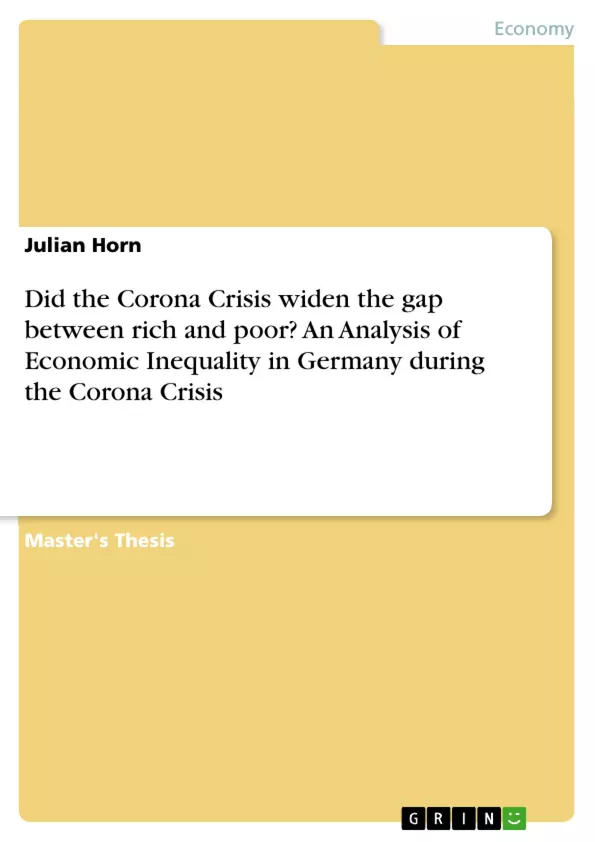This Master's thesis aims to address the in the media, politics and academia recurring issue of economic inequality against the background of the Corona crisis in Germany. Through a deductive literature analysis, the research question to what extend the economic inequality in Germany changed during the Corona crisis is answered. Due to the Corona pandemic that broke out in March 2020, almost all countries in the world were forced to contain the spread of infections as quickly as possible to not overburden healthcare systems. Severe restrictions were imposed almost worldwide, in some cases lasting already several months. In Germany two phases of severe residual restrictions, one beginning in March 2020 and another beginning in October 2020, also have persistently brought public life to a virtual standstill, thus having a considerable impact on the corresponding economic strength.
In addition to growth losses, high national debts, and other socioeconomic consequences the redistribution of economic assets and change in economic inequality has been controversially discussed in academia as well as in the media and thus crystallised as a current problem statement for science and politics. Regarding the state of research, it can be noted that representative surveys and studies of income distribution have published valid results and analyses in relation to the Corona crisis. The longer-term effects of wealth distribution are less well researched at this point of time. This paper incorporates published data and studies up to May 2021.
Inhaltsverzeichnis (Table of Contents)
- Introduction
- Research questions and hypotheses
- Methodology and data basis
- The term inequality and its key figures
- The concepts of income
- Market and net income
- Net equivalence income
- The concept of wealth
- The concept of poverty
- Gini coefficient and other indicators
- Framework and Development of economic inequality in Germany
- Economic framework in Germany
- Solid economic growth until the Corona crisis
- Labour market situation and the importance of short-time work
- Distribution of national income
- Income inequality in Germany
- Development of net equivalised disposable income
- Decline in wage inequality with gender pay gap remaining
- Development of the Gini coefficient and other indicators
- Trends in income poverty
- Decrease in material deprivation
- Developments at the upper end of the income distribution
- Asset distribution in Germany
- Gini coefficient and percentile distributions
- Relationship between income and assets
- Asset distribution in international comparison
- Changes in economic inequality due to the Corona crisis
- Short-term effects on the labour market
- The significant role of short-time allowances
- Marginally employed persons face major challenges due to the crisis
- Effects on market and disposable household income
- The Gender Pay Gap in the Corona Crisis
- Income inequality during the Corona pandemic in Europe
- Short-term effects on asset distribution
- Policy instruments to reduce economic inequality
- Financial support for the self-employed persons
- Assistance for marginally employed persons
- Spreading the costs of the pandemic fairly
- Limitations
Zielsetzung und Themenschwerpunkte (Objectives and Key Themes)
This Master's thesis investigates the impact of the Corona crisis on economic inequality in Germany. It aims to answer the research question of how the economic inequality in Germany changed during the crisis. Through a deductive literature analysis, the study explores the short-term effects of the crisis on income and wealth distribution, with a focus on the role of social security measures, labour market adjustments, and asset disparities.
- Economic Inequality in Germany
- Impact of the Corona Crisis
- Income and Wealth Distribution
- Role of Social Security Measures
- Labour Market Adjustments
Zusammenfassung der Kapitel (Chapter Summaries)
The thesis begins by defining key concepts related to economic inequality, including income, wealth, and poverty. It then provides an overview of the economic framework in Germany before the crisis, highlighting factors like economic growth, labour market dynamics, and the distribution of national income. The study then analyzes trends in income and wealth inequality in Germany prior to the crisis, focusing on the development of income and asset distributions, the Gini coefficient, and poverty indicators.
The fourth chapter investigates the short-term effects of the Corona crisis on economic inequality in Germany. It examines the impact of the crisis on the labour market, particularly the role of short-time work and the challenges faced by marginally employed individuals. The chapter also analyzes the effects of the crisis on income distribution, exploring changes in market and disposable household income and the gender pay gap. Finally, it provides an initial assessment of the impact of the crisis on asset distribution.
The fifth chapter explores policy instruments aimed at mitigating economic inequality in the wake of the Corona crisis. It focuses on financial support for self-employed individuals, assistance for marginally employed persons, and strategies for fairly distributing the costs of the pandemic.
Schlüsselwörter (Keywords)
This thesis focuses on key aspects of economic inequality, including income inequality, wealth inequality, poverty, the impact of the Corona crisis on economic disparities in Germany, social security measures, labour market changes, asset distribution, and policy instruments to reduce inequality.
- Quote paper
- Julian Horn (Author), 2021, Did the Corona Crisis widen the gap between rich and poor? An Analysis of Economic Inequality in Germany during the Corona Crisis, Munich, GRIN Verlag, https://www.grin.com/document/1165748



